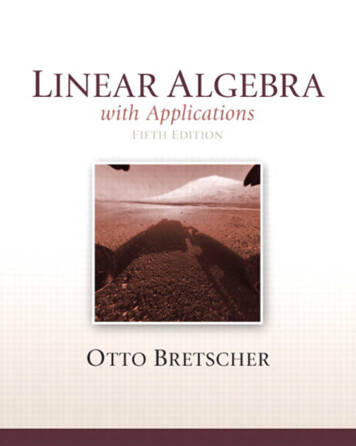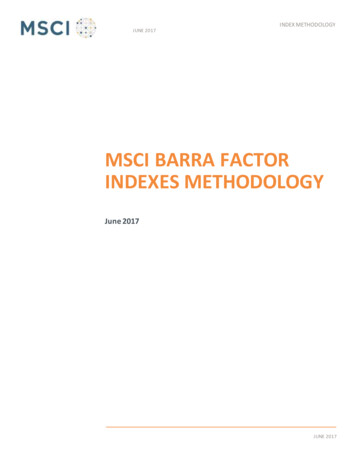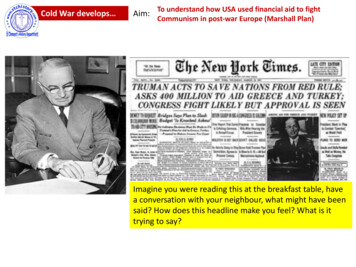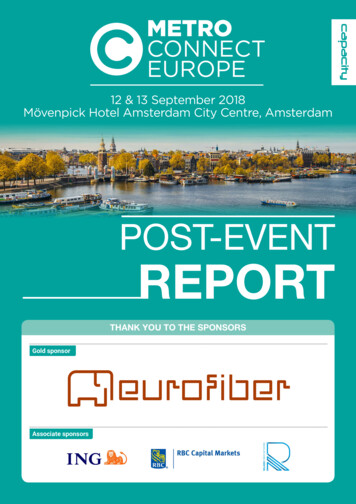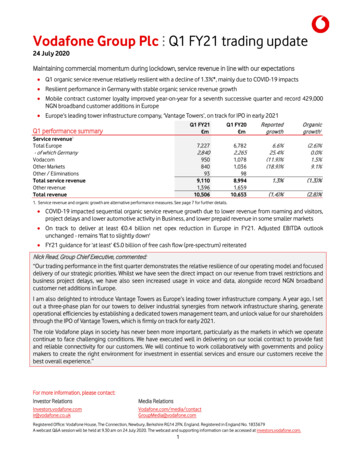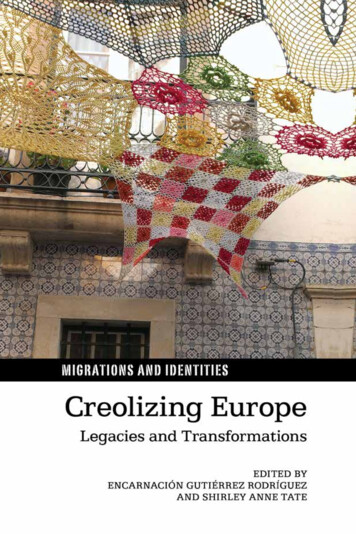
Transcription
Creolizing Europe
MIGRATIONS AND IDENTITIESSeries EditorsKirsty Hooper, Eve Rosenhaft, Michael SommerThis series offers a forum and aims to provide a stimulus for new researchinto experiences, discourses and representations of migration from acrossthe arts and humanities. A core theme of the series will be the varietyof relationships between movement in space – the ‘migration’ of people,communities, ideas and objects – and mentalities (‘identities’ in the broadestsense). The series aims to address a broad scholarly audience, with criticaland informed interventions into wider debates in contemporary cultureas well as in the relevant disciplines. It will publish theoretical, empiricaland practice-based studies by authors working within, across and betweendisciplines, geographical areas and time periods, in volumes that make theresults of specialist research accessible to an informed but not disciplinespecific audience. The series is open to proposals for both monographs andedited volumes.
Creolizing EuropeLegacies and TransformationsEncarnación Gutiérrez Rodríguezand Shirley Anne TateLiverpool University Press
First published 2015 byLiverpool University Press4 Cambridge StreetLiverpoolL69 7ZUCopyright 2015 Liverpool University PressThe authors’ rights have been asserted by them in accordance with the Copyright,Designs and Patents Act 1988.All rights reserved. No part of this book may be reproduced, stored in a retrievalsystem, or transmitted, in any form or by any means, electronic, mechanical,photocopying, recording, or otherwise, without the prior written permission of thepublisher.British Library Cataloguing-in-Publication dataA British Library CIP record is availableprint ISBN 978-1-78138-171-7epdf ISBN 978-1-78138-463-3Typeset by Carnegie Book Production, LancasterPrinted by BooksFactory.co.uk
In Memoriam,Édouard GlissantStuart Hall
AcknowledgementsAcknowledgementsThis volume first took shape within the Migration and Diaspora CulturalStudies Network (MDCSN),1* based at the University of Manchester, between2006 and 2011. MDCSN was initiated by Margaret Littler, University ofManchester, and Encarnación Gutiérrez Rodríguez, who was then also atthe University of Manchester, and was funded by the Arts and HumanitiesResearch Council (AHRC) between 2006 and 2007. Some of the papers givenin a series of workshops and an international conference ‘Creolizing Europe’,which took place in Manchester in 2007, are included in this volume. Wewould like to thank Margaret Littler for shaping earlier versions of thiscollection. We are also very indebted to Catherine Hall for her generosityin granting us permission to reprint Stuart Hall’s chapter ‘Creolité and theProcess of Creolization’. We would also like to thank publisher Hatje Cantzand editors Okwui Enwezor, Carlos Bausaldo, Ute Meta Bauer, SusanneGhez, Sarat Maharaj, Mark Nash and Ocatvio Zaya for their permissionto reprint his chapter. Our thanks also go to Katharina Piepenbrink andManuela Schmidt for their support at different stages of this project.*MDCSN was funded by the Arts and Humanities Research Council of Great Britainfrom 2006 to 2008.vi
ContentsContentsList of FiguresixList of ContributorsxIntroduction: Creolizing Europe: Legacies and Transformations1Encarnación Gutiérrez Rodríguez and Shirley Anne Tate1 Creolité and the Process of Creolization12Stuart Hall2 World Systems and the Creole, Rethought26Gayatri Chakravorty Spivak3 Creolization and Resistance38Françoise Vergès4 Continental Creolization: French Exclusion through aGlissantian Prism57H. Adlai Murdoch5 Archipelago Europe: On Creolizing Conviviality80Encarnación Gutiérrez Rodríguez6 Are We All Creoles? ‘Sable-Saffron’ Venus, Rachel Christieand Aesthetic Creolization100Shirley Anne Tatevii
7 Re-imagining Manchester as a Queer and Haptic BrownAtlantic Space118Alpesh Kantilal Patel8 Queering Diaspora Space, Creolizing Counter-Publics:On British South Asian Gay and Bisexual Men’sNegotiations of Sexuality, Intimacy and Marriage133Christian Klesse9 On Being Portuguese: Luso-tropicalism, Migrations and thePolitics of Citizenship157José Carlos Pina Almeida and David Corkill10 Comics, Dolls and the Disavowal of Racism: Learning fromMexican Mestizaje175Mónica G. Moreno Figueroa and Emiko Saldívar Tanaka11 Creolizing Citizenship? Migrant Women from Turkey asSubjects of Agency202Umut ErelIndex222
Figures1FiguresAgostino Brunias (1728–96), West India Washer Women, c.1773–75Courtesy of the Institute of Jamaica, The National Collection ofJamaica, West Indies1052Rachel Christie, Miss England 2009Courtesy of photoshot.com106
ContributorsContributorsDavid Corkill is a visiting lecturer at the University of Chester, havingpreviously worked at Manchester Metropolitan University, Universityof Portsmouth and Leeds University. He has written extensively on theeconomies and societies of Spain and Portugal.Umut Erel is Lecturer in Sociology and a member of the Centre forCitizenship, Identities and Governance at the Open University. Umut’sresearch interests are in migration, ethnicity, gender, class and citizenship.Recent publications include: Migrant Women Transforming Citizenship(2009) and ‘Kurdish Migrant Mothers Enacting Citizenship’, CitizenshipStudies (2013).Encarnación Gutiérrez Rodríguez is Chair in Sociology at the JustusLiebig University Giessen, Germany. Previous to her appointment in Giessenshe was a Senior Lecturer in Transcultural Studies at the University ofManchester. She is the author of Intellektuelle Migrantinnen (1999)and Migration, Domestic Work and Affect (2010), and the co-editor ofSpricht die Subalterne Deutsch? Migration und Postkoloniale Kritik (2003),Gouvernementalität (2003) and Decolonizing European Sociology (2010).Stuart Hall, influential cultural theorist, campaigner and founding editorof the New Left Review, was an Emeritus Professor at the Open University.In 2005, he was made a Fellow of the British Academy. His publishedwork includes the collaborative volumes Resistance Through Rituals (1975);Culture, Media, Language (1980); Politics and Ideology (1986); The Hard Roadto Renewal (1988); New Times (1989); Critical Dialogues in Cultural Studies(1996); and Different: A Historical Context: Contemporary Photographers andBlack Identity (2001). In 2013, with Doreen Massey and Michael Rustin, hepublished After Neoliberalism? The Kilburn Manifesto, a statement beingmade in twelve monthly installments, critically examining the nature ofneo-liberalism locally, in the United Kingdom, and globally.x
ContributorsxiChristian Klesse is Senior Lecturer in Cultural Studies in the Departmentof Sociology at Manchester Metropolitan University. His research interestsinclude sexual politics, sexual cultures and questions of embodiment. He iscurrently engaged in collaborative research on transnational LGBTQ politics(with a focus on Poland) and Queer Film Festivals in Europe. His mostrecent publications include a co-edited special issue on gender, sexualityand political economy in the International Journal of Politics, Culture andSociety (2014).Mónica G. Moreno Figueroa is a Lecturer in Sociology at the Universityof Cambridge. Previously she was a Senior Lecturer at the Universityof Newcastle. Her research and publications have focused on the livedexperience of ‘race’ and racism in Mexico; beauty, emotions and feministtheory; and visual methodologies and applied research collaborations. She iscurrently completing a book on the everyday life of racism in Mexico andhas published in a variety of journals and edited collections.H. Adlai Murdoch is Professor of Romance Languages and Director ofAfricana Studies at Tufts University. He is the author of Creole Identityin the French Caribbean Novel (2001); Creolizing the Metropole: MigratoryMetropolitan Caribbean Identities in Literature and Film (2012); and co-editorof the essay collections Postcolonial Theory and Francophone LiteraryStudies (2005); Francophone Cultures and Geographies of Identity (2013); andMetropolitan Mosaics and Melting-Pots: Paris and Montreal in FrancophoneLiteratures (2013).Alpesh Kantilal Patel is an Assistant Professor in Contemporary Art andTheory at Florida International University in Miami. He is also Director ofthe Master of Fine Arts programme in Visual Arts and an affiliate facultyof both the African and African Diaspora programme and the Women’s andGender Studies Centre. His book project, provisionally entitled ‘ProductiveFailure: Writing Queer Transnational South Asian Art Histories’, is undercontract with Manchester University Press.José Carlos Pina Almeida gained his Ph.D. in sociology at the University ofBristol in 2001. He was a lecturer at the Instituto Piaget, Portugal until 2006and since then has been a research fellow at the Migration Research Unitat University College London and at the Manchester European ResearchInstitute, Manchester Metropolitan University.Emiko Saldivar is Associate Researcher and Lecturer at the Universityof California in Santa Barbara. Previously she was a professor at theUniversidad Iberoamericana in Mexico City. She is the author of Prácticascotidianas del estado: una etnografía del indigenismo (2008). Her work
xiiCreolizing Europefocuses on race and ethnicity in Mexico and Latin America, with specialemphasis on state formation and indigenous people.Gayatri Chakravorty Spivak is a University Professor at Columbia Universityand a founding member of the Institute for Comparative Literature andSociety. Her academic work spans nineteenth- and twentieth-centuryliterature and politics. She is the author of many influential works, including:In Other Worlds: Essays in Cultural Politics (1987); Outside in the TeachingMachine (1993); A Critique of Postcolonial Reason: Towards a History of theVanishing Present (1999); Death of a Discipline (2003); Other Asias (2005) andAn Aesthetic Education in the Era of Globalization (2012) and is currentlyworking on a book entitled ‘Du Bois and the General Strike’.Shirley Anne Tate is Associate Professor in Race and Culture, Directorof the Centre for Ethnicity and Racism Studies at the University of Leedsand Visiting Professor in the Centre for Reconciliation and Social Justice,University of the Free State, South Africa. She has published on racedintersections, the body, beauty, affect, post/de-colonial theory, critical mixedrace, race performativity and racism.Françoise Vergès is currently Chair Global South(s) at the Collège d’étudesmondiales, Paris and Consulting Professor, Goldsmiths College, Universityof London. She is the author of numerous articles and books on thememories of colonial slavery, Frantz Fanon, Aimé Césaire, the processes ofcreolization and the postcolonial museum. She is also the author of filmscripts and an independent curator.
Introduction: Creolizing Europe:Legacies and TransformationsEncarnación Gutiérrez Rodríguezand Shirley Anne TateIntroduction‘The whole world is becoming an archipelago and becoming creolized’.Édouard Glissant, ‘The Unforeseeable Diversity of the World’While anthropologists and cultural historians have related ‘creolization’ toprocesses of transformation produced by colonial rule, slavery and agrariancapitalism (Mintz, 1996; 2008; 2010; Stewart, 2007), other scholars haveexplored creolization as an expression of global cultural mixing or as atheoretical proposal reaching beyond the Caribbean region (Cohen, 2007;Cohen and Toninato, 2010; El-Tayeb, 2011, 2014; Gowricharn, 2006; GutiérrezRodríguez, 2010, 2011; Hannerz, 1987, 1992, 1996, 2002; Lionnet and Shih,2011; Mudimbe-Boyl, 2002; Pratt and Rosello, 2007). However, the decolonialepistemological contribution of Caribbean intellectuals (Balutansky andSourieau, 1998; Britton, 1999; Forsdick and Murphy, 2009; Nesbitt, 2013) –such as C.L.R. James (Balutansky, 1997; King, 2001), Frantz Fanon (1967),Lewis R. Gordon (1997), Eric Williams (1994), Edward Kamau Brathwaite(1971), Walter Rodney (1969), Marcus Garvey (2005), Sylvia Wynter (1989),Jean Bernabé, Patrick Chamoiseau, Raphaël Confiant (1990), Stuart Hall(2003) and particularly Édouard Glissant (1996) – in conceptualizing1
2Creolizing Europe‘creolization’ in political, economic, cultural and theoretical terms,1 hasbeen underestimated in these writings.Creolizing Europe aims to reverse this tendency by critically interrogatingcreolization (see in this volume Spivak; Hall; and Vergès) as the decolonial,rhizomatic thinking necessary for understanding the social and culturaltransformations set in motion by trans/national dislocations, a Glissantiananalytics of transversality and what Encarnación Gutiérrez Rodríguez (2011;and in this volume) terms ‘transversal conviviality’. In this sense, Stuart Hall’schapter on ‘Créolité and the Process of Creolization’ sets out the theoreticalorientation that guides this volume in his challenge to seek out creolization’s applicability outside of the Caribbean. Gaytri Chakravorty Spivak’s‘World Systems and the Creole, Rethought’ also addresses the limitation ingrasping the theoretical and policy implications of the proposal of creolization. Discussing creolity rather than kinship as a model for comparativistpractice, Spivak suggests that we start with Dante’s understanding of popularItalian as varieties of Creole and his choice of an aristocratic (‘curial’)political Creole as ‘Italian’, as this will enable us to perceive the beginningsof European nationalisms as grounded on a creolized understanding ofthemselves while asserting kinship. Engaging with the French-Reunionpolitics of remembrance, Françoise Vergès’s chapter on ‘Creolization andResistance’ discusses the persistence of politics of oblivion in the formermetropoles of colonial power. Her discussion on the Maison des civilisationset de l’unité réunionnaise argues for a need to imagine a postcolonialmuseography for a society still undergoing creolization.Departing from these theoretical insights, Creolizing Europe engagesin an interdisciplinary, transnational dialogue between the social sciencesand humanities as it juxtaposes US–UK debates on debates on ‘hybridity’and ‘mixing’ (see in this volume Tate, Klesse and Erel), ‘mixedness’ (see inthis volume Klesse; and Erel) and the ‘Black Atlantic’ (see in this volumePatel) with Caribbean and Latin American (see in this volume Moreno andSaldivar) theorizations of cultural mixing in order to engage with Europeas a permanent scene of Édouard Glissant’s (1981, 1990, 1996, 1997a, 1997b,2002) creolization (see in this volume Murdoch; Gutiérrez Rodríguez; andAlmeida and Corkill). This last is important given the political changesmulticultural societies have undergone particularly since 9/11 (Gilroy, 2004;Lentin and Titley, 2011), articulated in increasingly restrictive immigrationpolicies and calls for ‘integration’ allied with ‘failure of multiculturalism’discourses. Such a context leads to urgency in revisiting once again thedecolonial potential of creolization which we have seen historically in thelocations of its emergence.1For further elaboration, see Gordon 2009; Gordon and Roberts 2009; Monahan 2011.
Introduction3The historical dimensionThe term ‘Creole’ was applied in areas of European colonial overseasexpansion. A list of localities where people, at one time or another, havebeen called ‘Creole’ (or called themselves thus) would have to include notjust the Caribbean and much of Latin America, but also parts of thesouth-eastern USAs (and Alaska), several island groups off the Atlantic andPacific coasts of Africa, a number of mainland regions on that continent(including Sierra Leone, Equatorial Guinea, Angola and Mozambique) and afew pockets in the former Portuguese and Dutch colonies in Southern Asia(Knight, 1997; Spitzer, 2003; Eriksen, 2003; Palmié, 2006). Yet the commonpoint of reference in the contemporary literature on creolization tends tobe the Caribbean.The term ‘Creole’ first appears as ‘criollo’ in the documentary recordsof the Iberian colonization of the Américas as a Portuguese term whosegenealogy is still being debated.2 By the second half of the sixteenth centurythe term began to designate fairly consistently the modification that OldWorld life forms were perceived to undergo upon becoming ‘native’ to theAméricas. What it certainly did not imply at this time were notions ofexplicitly ‘racial’ or ethnic difference or mixedness. What early usages ofcriollo tend to connote is a sense of alterity from the metropolitan worldbrought about by the indigenization of self-identified peripherals (Arrom,1951). This is also the sense that such terminology continued to carry in itstranslation into English and French in the second half of the seventeenthcentury as a referent to New World-born Europeans and Africans (Palmié,2007; Stephens, 1983). Thus there was a differentiation between the ‘creolizedpopulation’ and the first-generation European colonizers. By the end ofthe eighteenth century, and especially upon the founding of the first LatinAmerican nation states in the early nineteenth century, the semantic cargotransported by the term criollo in continental American Spanish began todiverge dramatically from the older meanings it continued to hold in Spain’sremaining Caribbean colonies.Latin American criollismo mutated into an ideology of exclusion by theearly twentieth century. On this basis a citizenship model of insiders andoutsiders to the nation was developed, serving to demarcate supposedly2Stephens suggests that the first appearance of the term ‘Creole’ was in Portuguese(crioulo). Yet, the first use of the term is documented in Spanish. The Spanishcolonizers born in the Américas were named ‘criollo’ (Stephens, 1983, 28–39). Further,Arrom (1951, 175) notes that the etymological root of ‘crioulo’ and ‘criollo’ lie in inthe verb ‘criar’ (to raise, nourish, create) and noun ‘cria’ (infant, baby, person withoutfamily) and that the ending –oulo or –olo refers to a diminutive, which leads him tothe conclusion that the term was originally used to refer to children born in exile, andlater on to adults.
4Creolizing Europe‘non-Creole’ collective identities and exclude them from citizenship rights,as was the case for the indigenous and African heritage populations. Suchpostcolonial ideological elaboration of the concept of ‘criollismo’ was characteristic of mainland Ibero-America and the Hispanic Caribbean (Alberro,1992). This model introduced an ethnic and racialized social order andsocio-economic structure in which ‘criollo’ meant the ‘new elites’, largelydescendants of White Spanish colonizers. In this context, cultural mixingwas inscribed in power asymmetries as the economies of mainland LatinAmerica and the Hispanic Caribbean were in the hands of the ‘criollos’(Buisseret and Reinhardt, 2000).Due to the near-genocide of the Caribbean’s indigenous populations atthe hands of the Spanish, colonialism’s demand for plantation labor wasmet initially by indentured labor from Europe, then several centuries ofAfrican enslavement, with post-abolition indentured laborers mainly fromthe Indian subcontinent and China (Mintz, 1985). Plantation slavery, alongwith maroonage and subsistence farming, created transcultural contactzones where cultures met, clashed and grappled with each other, often inhighly uneven relations of power (Ortiz, 1995; Pratt, 1992). The articulationsof new cultural and social forms were intrinsically linked to histories ofstruggle against slavery and for independence in mid-seventeenth-centuryAnglophone Caribbean plantation societies (Brathwaite, 1971; 1974). In theFrench Antilles it was not the white elites but the African-descent populationwho were the point of reference for the process of creolization (James, 2001[1938]). In the Caribbean context, creolization was founded on the necessityto survive the plantation system and was carried forward in the face ofsuffering by the affective and creative potential of agents to recuperate lossand re-create social identity.CreolizationIt is this aspect of power asymmetries that Stuart Hall (1993; and in thisvolume) discusses as emblematic of the process of creolization in theCaribbean. For him this process represents the primal scene of tragedy inthe matrix of cultural contact and negotiations between what he termedprésence africaine, présence européenne and présence américaine. Theserepresent the productive antagonisms of racial oppression, imperialism andindigenization in which the Caribbean was formed. It is in this conjuncturalaxis that we discuss ‘creolizing Europe’, focusing particularly on Hall’s (2003,31) assertion that creolization ‘always entails inequality, hierarchization,issues of domination and subalternity, mastery and servitude, control andresistance’. Needless to say, Hall’s approach to creolization is inspired byGlissant.As early as his writings in the 1950s, Glissant embraced the visionaryand revolutionary spirit of decolonization. In 1958, when he was awarded the
Introduction5renowned French literary Prix Renaudot for his novel Le Lézarde, Glissantwas already part of a group of well-known decolonial African and Caribbeanintellectuals writing in French and English (for further discussion, see Dash,1995; Vergès, and Murdoch in this volume). As a member of the ‘Fédérationdes étudiants d’Afrique noire en France’, the ‘Société Africaine de culture’and contributor to the journal Présence africaine, Glissant actively participated in debates on an independent future for African and Antillean states.In 1956, he attended the First International Congress of Black Writers andArtists, in Paris, and, with other Antillean intellectuals and writers such asAlbert Béville, Cosnay Marie-Joseph and Marcel Manville, he founded the‘Front des Antillais et Guyanais pour l’autonomie’, in 1961, supporting thedecolonization of the Antilles and French Guyana.3Drawing on this legacy but setting a rather different accent, theMartinican intellectuals Jean Bernabé, Patrick Chamoiseau and RafaëlConfiant developed the concept of ‘creolité’ (creoleness) to emphasize thequality of existence established by the process of creolization. In their 1989publication Éloge de la Créolité (translated in 1990 as In Praise of Creoleness),4they established the concept of ‘créolité’ as a point of departure for thinkingcreoleness. Drawing on the work of Aimé Césaire and Édouard Glissant,Bernabé, Chamoiseau and Confiant (1990,10) sought to elaborate an ethics ofvigilance, ‘a sort of mental envelope in the middle of which our world willbe built in full consciousness of the outer world’. Through the concept ofcreolité, they tried to capture the specificity of Caribbean people, who werenot Europeans, Africans or Asians, but Creoles (Bernabé, Chamoiseau andConfiant, 1990). Thus, they introduced a vision of diversity, which, althoughbased on the intellectual tradition of the Negritude movement, went beyondit by creating a space for what they described as a ‘kaleidoscopic totality’, the‘nontotalitarian consciousness of a preserved diversity’ (28). This perspectiveintroduces us methodologically to what Glissant (1996) calls an ethnographic ‘poetics of relation’ and an ‘analytics of transversality’. However,this approach has not been without critique.For example, the eminent Guadeloupean writer Maryse Condé hasidentified the limitations of creolité, as it has not taken into account otherhistorical creoles, such as those to be found on the west coast of Africa (see,for further discussion, Cottenet-Hage and Condé, 1995; Kemedjio, 1999).From Spanish Caribbean and Latin American and Anglophone Caribbeanperspectives, we could also note that the concept of creolité is specific tothe French Caribbean context. Thus, we need to consider the modern andhistorical usages and meanings of creolization, as without this we risk theerasure of historical semantic and regional differences (Palmié, 2006; Knörr,34For further biographical notes on Glissant, please see www.edouardglissant.fr.Bernabé, Chamoiseau, and Confiant 1990.
6Creolizing Europe2010). Considering this historical background, it is interesting that the termhas reappeared in recent years.Glissantian creolization is useful for understanding contemporaryEuropean societies because of its focus on the analysis of power asymmetries.As Glissant notes, creolization must not be confused with métissage, themechanical act of cultural mixing. Rather, creolization engages with the‘unforeseeable’ (‘l’inattendue’) (Glissant, 1996), ‘le différance que se metteau contact et que produise l’imprévisible’5 (Glissant, 2010). Creolization isan outcome of racialized living together which goes beyond racial codingthrough the contact of different affects, desires, energies and intensities thatbreak the established normative order of the governance of diversity. It isthis break through the analytics of transversality that produces transversalconviviality that challenges the normative power of the One (GutiérrezRodríguez in this volume). Thus, creolization, as decolonial rhizomaticthinking, engages with an ethics of conviviality. Therefore, its interest is notin accommodating cultural differences under a hegemonic order because ofits departure from a racialized understanding of conviviality itself. Thus,while Sidney Mintz (1998) counters celebratory approaches to culturalmixing that flatten the historical specificity of creolized nations,6 Glissantis interested – as we are in this volume – in the potential of creolization forchallenging occidental notions of identity and belonging that reproduce theSelf/Other binary. In the post/colonial context, the ‘Other’ is constructedas inferior to the hegemonic White, Male, European Self and this wasfoundational to the establishment of the racial social classification systemsustaining the coloniality of power (Quijano, 2000) that still persists.In our contemporary times of economic crises, austerity measuresand cuts in public spending affect, in particular, poor white people, post/migrants and refugees. The cuts in health care for undocumented migrantsin Spain; the July 2013 discussion in the UK that people who stay longer thansix months in the country should pay for National Health Service (NHS)care to stop ‘health tourism’; and the deportation of undocumented migrantsthroughout Western Europe represent the tip of the iceberg of responsesto Europe’s ‘exteriority’ (Dussel, 1995). Here those coded as non-citizensare removed from the realm of human and citizenship rights. It is inthis context that the decolonial epistemological move that Glissant andHall propose through creolization becomes a vital resource for analyzingEuropean societies.56English translation (Encarnación Gutiérrez Rodríguez: EGR): ‘the difference that comesinto contact and produces the unforeseeable’.Creolization ‘had been historically and geographically specific. It stood for centuries ofculture building rather than culture mixing or culture blending, by those who becameCaribbean people. They were not becoming transnational; they were creating forms bywhich to live’ (Mintz, 1998, 119).
Introduction7Translating creolization to EuropeThe differences embedded in the concept of creolization show the necessityfor resisting ahistorical and solely celebratory uses of this term. Indeed,to French Antillean cultural critics, créolité and creolization are distinctnotions. Glissant favors creolization over créolité because the former refersto an ongoing process which always leads to unknown consequences thatcannot be foreseen. As the organizers of documenta 11 Platform 3 note, thereis a productive experience of the unknown, which we must not fear.Talking of this experience, Glissant harks back to the plantation, agouffre-matrice, one of the ‘wombs of the world’. Today’s world is againexperiencing the chaos of the plantation, especially in the context ofglobalization. (Enwezor et al., 2003, 15)Glissant elaborates a theory of creative disorder that transcends thebattle lines of center and periphery, North and South, dependence andindependence.In the European context, we need to relate creolization to the colonialpast and the transformation of societies produced through postcolonialmigratory, diasporic and exilic movements. Thus, creolization frames a spacein which national rhetoric about identity and community are contestedand challenged. This leads us then to think more broadly of moments ofcultural mixing and transversal conviviality. In this sense, Glissant (1997a;1997b; 2002; Glissant and Chamoiseau, 2009) describes Europe as inevitablyinscribed in the project of creolization. Following Glissant’s (1997a; 1997b;2002; Glissant and Chamoiseau, 2009) observation of the ‘irreversible creolization of the world’, what do we mean by ‘creolizing Europe’? Instead of thecultural fusion of multicultural and hybridity discourses, Creolizing Europemeans living with cacophonies, irritations and discordances within the racedintersectionalities of everyday life. Thus, creolization is not just a ‘syncreticprocess of transverse dynamism that endlessly reworks and transforms thecultural patterns of varied social and historical experiences and identities’(Balutansky and Sourieau, 1998, 1). Rather, creolization speaks about thecreation of new articulations not inscribed in any hegemonic script. It isthe creation of a new vocabulary that transcends the normative order stillinvested in recreating the colonial gaze. In this sense, Glissant speaks of thelanguages of the ‘creolized streets’ of Rio de Janeiro, Mexico, the Parisiansuburbs or Los Angeles (Schwieger Hiepko, 1998). For him these spacesshow the speed of cultural innovation and creativity. He notes that notall of these cultures and subcultures last, but they leave affective traces intheir communities. For Glissant, the moment of creolization is not fixed bygeography as we live in a world in motion where languages, identity andcultures are in a constant state of fl
José Carlos Pina Almeida gained his Ph.D. in sociology at the University of Bristol in 2001. He was a lecturer at the Instituto Piaget, Portugal until 2006 and since then has been a research fellow at the Migration Research Unit at University College London and at the Manchester European Research Institute, Manchester Metropolitan University.
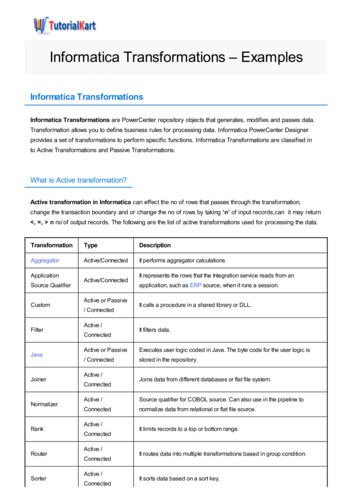

![The Rise Of Nine Pittacus Lore Pdf Free [Extra Quality]](/img/36/glenraf-1.jpg)
